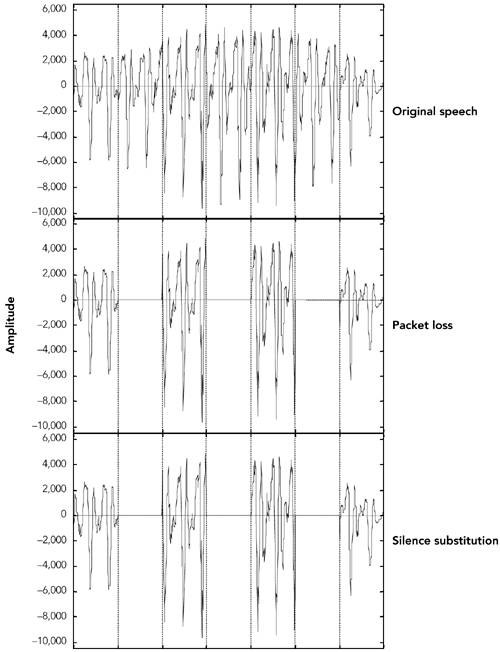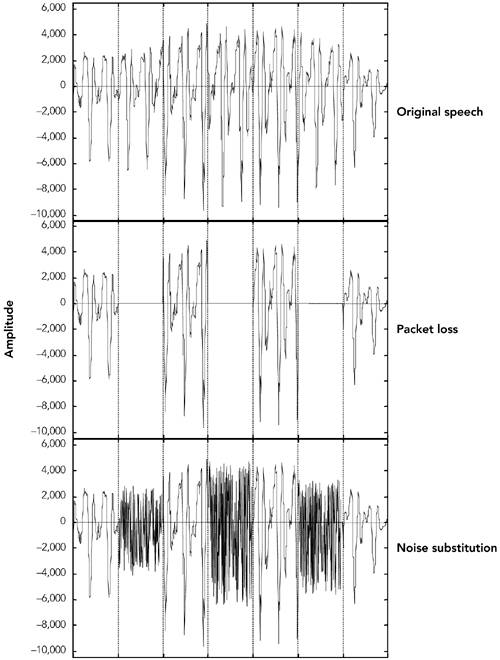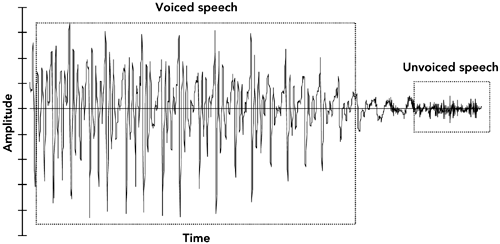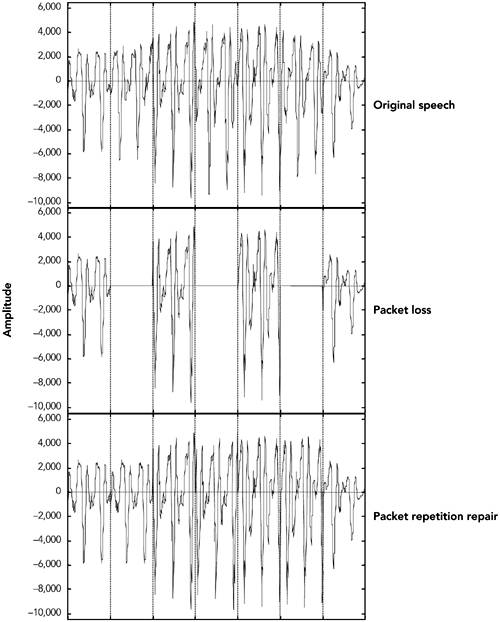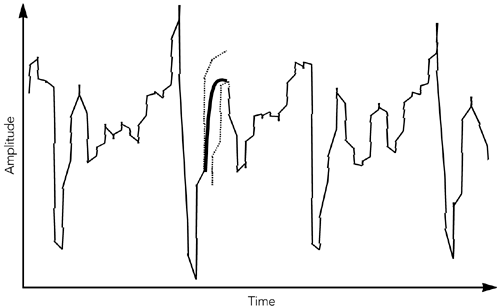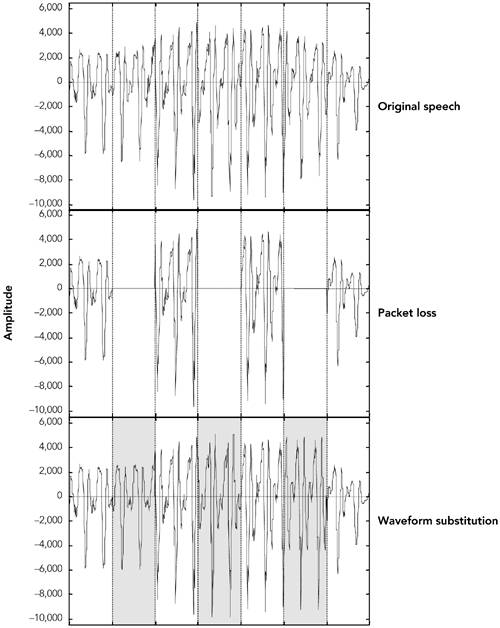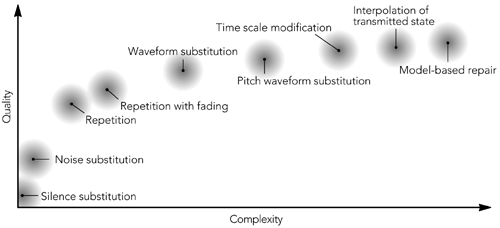Techniques for Audio Loss Concealment
Techniques for Audio Loss ConcealmentWhen an RTP packet containing audio data ”whether music or speech ”is lost, the receiver has to generate a replacement to preserve the timing of the media stream. This can be done in many ways, and the choice of concealment algorithm can have a significant impact on the perceived quality of the system in the case of loss. Measuring Audio QualityHuman perception of sound is a complex process, and the perceptual significance of distortion depends not just on the amount the signal has changed, but also on the type of damage caused, and where it occurred in the signal. Some types of distortion are more noticeable to listeners than others, even if ”by some objective measure ”they change the signal by the same amount. It is also common for different listeners to perceive a particular type of distortion in different ways, and to rate concealment schemes differently depending on the material to which they are applied. This makes it very difficult to devise objective quality measurements for different repair schemes. It is not sufficient to measure the difference between the original waveform from the source and the waveform recovered at the receiver, because the perceived quality has no direct relation to the differences in the waveforms. Simple measures, such as the signal-to-noise ratio, are effectively useless. More complex schemes (for example, those in ITU recommendations P.861 and P.862 63 , 64 ) give results that are approximately correct for speech, but even these are not 100% reliable. When objective measurements fail, we need to resort to subjective tests. By conducting listening tests with a wide range of subjects, materials, and error conditions, we can measure the effectiveness of different repair schemes in a manner meaningful to the listener. These tests involve playing different types of music, or a range of words, phrases, and sentences subject to different error conditions and concealment techniques, with the listener rating their quality and/or intelligibility according to a particular scale. The choices of material and rating scale depend on what is being measured. If you are attempting to measure the perceived quality of speech ("does it sound good?"), then rating samples on the basis of a Mean Opinion Score (MOS) is appropriate. The MOS is a five-point rating scale, the results of which are converted into numeric form ( excellent = 5, good = 4, fair = 3, poor = 2, bad = 1) and averaged across all the listeners, giving a numeric result between 1 and 5. For the results to be statistically valid, it is necessary to make a large number of tests comparing different samples. Typical MOS scores for unimpaired speech are 4.2 for the G.711 codec (that is, standard telephone quality) and between 3.5 and 4 for mobile telephony (for example, GSM, QCELP). Packet loss will lower these numbers , with the degree of loss and the type of concealment determining the actual result. MOS scores provide a reasonable measure of perceived quality, allowing comparison between different codecs and repair techniques, but they do not measure intelligibility (that is, whether the audio is understandable). There is a difference between what sounds good and what conveys information; it is possible to define a concealment scheme that gets very good marks for sound quality but may not produce intelligible speech. In tests for intelligibility, listeners copy down sentences or words played with different impairments, or answer questions on a passage of text, and the result is a measure of how many errors are made. Again, a large number of tests must be conducted for the results to be statistically meaningful. Perhaps the most important point learned from listening tests is that the results vary depending on the persons listening, the material they are listening to, the type of distortion present in the sound, and the task they are performing. Depending on the application, it may be important to conduct tests of both perceived quality and intelligibility, and it is always necessary to ensure that the test material and packet loss rates match those of typical usage. Silence SubstitutionThe simplest possible repair technique is silence substitution, in which gaps caused by packet loss are filled with silence of the appropriate duration, as shown in Figure 8.1. This is the cheapest and easiest method to implement, and one of the most commonly used techniques. Figure 8.1. Repair Using Silence Substitution (Adapted from C. Perkins, O. Hodson, and V. Hardman, "A Survey of Packet Loss Recovery Techniques for Streaming Media," IEEE Network Magazine, September/October 1998. 1998 IEEE.) Unfortunately, silence substitution is also the worst repair scheme, consistently rated last in listening tests designed to evaluate repair quality. 114 Listening trials have shown that silence substitution is effective only with short-duration packets (<16 milliseconds ) and low packet loss rates (<2%). Performance degrades rapidly as the packet size and loss rate increase, becoming rapidly unusable with the packet sizes used in voice-over-IP applications, and with the loss rates encountered in many networks. 75 , 82 Implementations should not use silence substitution. Any of the techniques described next will give better-quality sound, with a very small increase in complexity. Noise SubstitutionBecause silence substitution has been shown to perform poorly, the next choice is to fill the gap left by a lost packet with background noise of some sort ”a process known as noise substitution (see Figure 8.2). Figure 8.2. Repair Using Noise Substitution (Adapted from C. Perkins, O. Hodson, and V. Hardman, "A Survey of Packet Loss Recovery Techniques for Streaming Media," IEEE Network Magazine, September/October 1998. 1998 IEEE.) At its simplest, noise substitution is the addition of white noise ”noise with uniform amplitude at all frequencies ”in place of the missing signal, amplitude matched to the previous packet. Here it is represented in pseudocode: void substitute_noise(sample previous_frame[samples_per_frame], sample missing_frame[samples_per_frame) { double energy; // Calculate energy (amplitude) of the previous frame energy = 0.0; for(j = 0; j < samples_per_frame; j++) { energy += previous_frame[j] * previous_frame[j]; } energy = sqrt(energy); // Fill in the noise for(j = 0; j < samples_per_frame; j++) { missing_frame[j] = energy * random(-1,1); } } Note that a real implementation will likely replace the arrays with a rotating buffer of the last few frames received, discarding old frames after they have been played out. Listening tests with speech have shown that, when compared to silence substitution, the use of white-noise substitution with approximately the same amplitude as the signal gives both subjectively better quality 88 and improved intelligibility. 114 There is a perceptual basis to this improvement in quality: Studies have shown that phonemic restoration , the ability of the human brain to subconsciously repair missing segments of speech with the correct sound, occurs for speech repaired with noise, but not when silence is used as the repair. Because white noise is almost as easy to generate as silence, it is to be recommended as a replacement for silence substitution. If the spectral characteristics of the signal are known, it may be possible to tailor the generated noise to match the original more closely than can be done with white noise. Many payload formats facilitate this task by providing comfort noise indicator packets to be sent during silence periods. Support for comfort noise allows the receiver to play an appropriate form of background noise when there is otherwise nothing to hear, and it can make the system seem more natural. For payload formats that don't include native support for comfort noise, there is a standard comfort noise payload format that may be used to transport this information (static payload type 13 in the default audio/video profile 42 ). This comfort noise format conveys two pieces of information: the amplitude of the noise, and the spectral parameters. The amplitude allows the receiver to generate amplitude-matched noise; the spectral parameters enable shaping of the noise to match the surrounding signal. RepetitionDepending on the content of the audio signal, it may be possible to provide a replacement for a lost packet that is somewhat similar to the original. This is especially true of speech signals, which are interspersed with repetitive patterns, known as pitch cycles , that typically last from 20 milliseconds to 100 milliseconds. Losses that occur during pitch cycles have a good probability of being concealed. Figure 8.3 shows a typical speech signal. Although many features can be recognized, the main differentiation is between voiced and unvoiced speech. Voiced speech, generated by the periodic opening and closing of the vocal folds (commonly called the vocal cords), generates regular, high-amplitude pitch cycles with frequency in the approximate range of 50Hz to 400Hz. Voiced segments often last for many tens or even hundreds of milliseconds, allowing the loss of a single packet of voice speech to be effectively repaired by substitution of the contents of the preceding packet. This phenomenon is reflected in Figure 8.4, which shows that loss repaired by repetition can be very similar to the original, except for the sharp discontinuity at the edges of the repaired region. Figure 8.3. Speech Waveform Figure 8.4. Repair of Voiced Speech Using Packet Repetition (Adapted from C. Perkins, O. Hodson, and V. Hardman, "A Survey of Packet Loss Recovery Techniques for Streaming Media," IEEE Network Magazine, September/October 1998. 1998 IEEE.) Unvoiced speech ”consisting of sounds such as s, f , and sh ”is generated by air being forced through a constriction in the vocal folds, and it closely resembles low-amplitude noise. Again, replacing a lost period of unvoiced speech with the contents of the previous packet produces reasonably good repair. Repetition clearly works best when the gap is small, because the characteristics of the signal are likely to be similar across the gap. One can improve the performance of repetition with longer gaps by gradually fading the repeated signal. For example, the GSM mobile telephony system recommends an identical repeat for the first lost packet, followed by a gradual fade to zero amplitude over the next 16 packets (320 milliseconds total duration), or until the next packet is received. 60 The repetition algorithm can be outlined in pseudocode like this: void repeat_and_fade_frame(sample previous_frame[samples_per_frame], sample missing_frame[samples_per_frame], int consecutive_lost) { // Repeat previous frame for (j = 0; j < samples_per_frame; j++) { missing_frame[j] = previous_frame[j]; } // Fade, if we've lost multiple consecutive frames if (consecutive_frames_lost > 0) { fade_per_sample = 1 / (samples_per_frame * fade_duration_in_frames); scale_factor = 1.0 (consecutive_frames_lost * samples_per_frame * fade_per_sample); if (scale_factor <= 0.0) { // In case consecutive_frames_lost > // fade_duration_in_frames scale_factor = fade_per_sample = 0.0; } for (j = 0; j < samples_per_frame; j++) { missing_frame[j] *= scale_factor scale_factor -= fade_per_sample } } } Note that the previous_frame[] array represents the previous frame received, not any previously repaired frame. The playout buffer should maintain the variable consecutive_lost based on the RTP sequence numbers, and should keep track of original versus repaired frames (in case one of the original frames was merely delayed). Listening tests show that repetition works better than noise substitution for speech signals, and it is simple to implement. Repetition works better with speech than with music because the characteristics of music are more varied. Noise matched to the frequency spectrum of the signal may be a better choice for music signals. Other Techniques for Repairing Speech SignalsThe three simple repair techniques ”silence substitution, noise substitution, and repetition ”form the basis of many error concealment systems, and when correctly applied they can give good performance with low implementation complexity. Researchers have also studied a range of more specialized error concealment techniques for speech. These techniques typically trade increased complexity of implementation for a modest improvement in performance, and they are often tailored to particular types of input. Various techniques based on waveform substitution have been proposed for use with speech. These techniques generate a suitable replacement packet based on characteristics of the speech signal surrounding a lost packet, and they can be viewed as extensions of packet repetition. Unlike basic packet repetition, waveform substitution algorithms adapt the repair to avoid discontinuity at the edges of the gap, and to match the characteristics of the signal better. As an example of waveform substitution, consider the algorithm proposed by Wasem et al., 107 building on earlier work by Goodman et al. 74 This algorithm first classifies speech as voiced or unvoiced (for example, by detecting the periodic spikes due to voiced pitch cycles). If the speech surrounding the loss is unvoiced, packet repetition is used to fill the gap. If the surrounding speech is voiced, a pattern-matching repair algorithm is used to find the region to repeat. The pattern-matching repair algorithm uses the last few milliseconds of speech before the gap as a template. A sliding window algorithm is then used to compare the template with the rest of the packet, noting the location of the best match. The region between the template and its best match forms a complete pitch cycle, which is repeated to fill in the gap. Because the template closely matches the original, there is no significant discontinuity at the start of the repair. In pseudocode, the algorithm can be written this way: void pattern_match_repair(sample previous_frame[samples_per_frame], sample missing_frame[samples_per_frame], int consecutive_frames_lost) { // Find best match for the window of the last few samples // in the packet window_start = samples_per_frame - window_length; target = infinity; for(i = 0; i < window_start; i ++) { score = 0; for(j = i, k = 0; k < window_length; j++, k++) { score += previous_frame[j] - previous_frame[window_start + k]; } if (score < target) { target = score; best_match = i; // The start of the best match for the // window } } pattern = best_match + window_length; pattern_length = samples_per_frame pattern; // "pattern" now points to the start of the region to repeat. // Copy the region into the missing packet dest = 0; for (remain = samples_per_frame; remain > 0; remain -= pattern_length) { for (j = 0; j < min(remain, pattern_length); j++) { missing_frame[dest++] = previous_frame[pattern + j]; } } // Fade, if we've lost multiple consecutive frames if (consecutive_frames_lost > 0) { fade_buffer(missing_frame, consecutive_frames_lost); } } There is still a boundary discontinuity at the end of the repair. We can patch this by merging the repair with the original data, provided that the two overlap. Such a patch is illustrated in Figure 8.5, where the weighted average of the two waveforms is used in the overlap region, providing a smooth transition. Weighting means to take more of the first waveform at the beginning of the overlap region and more of the second waveform at the end. Figure 8.5. Packet Merging at the Boundary of a Repair The result is a very effective repair algorithm for speech, which noticeably outperforms repetition. A sample speech waveform repaired by waveform substitution is shown in Figure 8.6. Figure 8.6. Repair Using Waveform Substitution (Adapted from C. Perkins, O. Hodson, and V. Hardman, "A Survey of Packet Loss Recovery Techniques for Streaming Media," IEEE Network Magazine, September/October 1998. 1998 IEEE.) Researchers have proposed a seemingly endless series of error concealment techniques that offer incremental improvements over those discussed here. These techniques include the following:
Applications that deal solely with speech may want to consider these more complex repair schemes. Be aware, however, that the gains are incremental and the increase in complexity is considerable (see Figure 8.7 for a rough chart of quality versus complexity). Figure 8.7. Rough Quality/Complexity Trade-off for Error Concealment in Speech Signals (From C. Perkins, O. Hodson, and V. Hardman, "A Survey of Packet Loss Recovery Techniques for Streaming Media," IEEE Network Magazine, September/October 1998. 1998 IEEE.) |
EAN: 2147483647
Pages: 108
